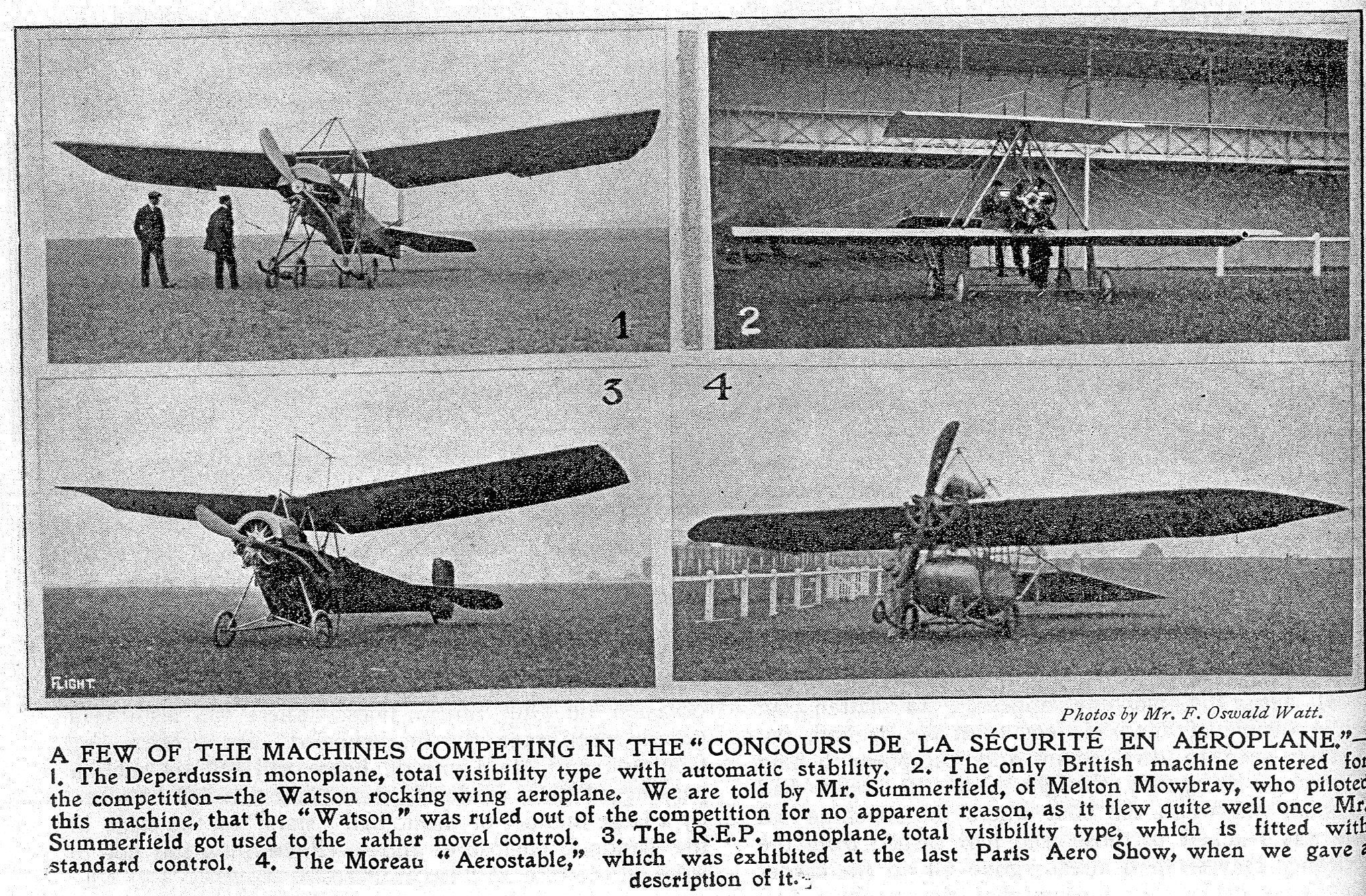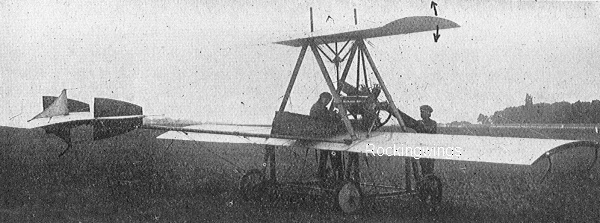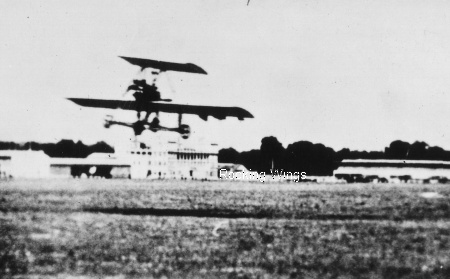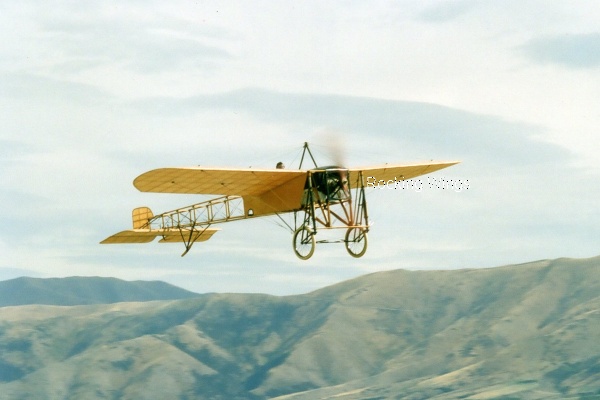From 1 January to 1 July 1914, L'Union pour la Sécurité en Aéroplane organisation held the first Concours de La Sécurité en Aéroplanes at Buc aerodrome, near Paris, in which some 56 aircraft were entered with the intention of displaying advances in safety devices for aeroplanes from a design standpoint.
Over the following six months of the Concours, a small number of the aircraft that entered demonstrated their particular features. A prevalent theme of several designs was automatic stability in flight, which, due to a lack of adequate lateral control was a condition strived for in aircraft design in Europe prior to the appearance of Wilbur Wright and his wing warping Flyer in France in 1908. These aircraft designs were commonly known as ‘total stability types’; their principle characteristic being the ability to right themselves naturally when a wing tipped below the horizontal. Almost all had mainplanes with prominent dihedral.
One particular innovation that survives today in aeroplanes is the gyro-stabilised autopilot. Fitted to a Curtiss flying boat, the Sperry-Curtiss stabiliser was a simple device that consisted of a quadruple gyroscope that actuated the ailerons and elevator; the gyro was driven by the flying boat's engine at a rate of 12,000 rpm. Longitudinal control was regulated by a small wind vane attached to an upright strut holding the powerplant in place between the flying boat's wings, which actuated one of the gyros.
In June Lawrence B. Sperry, the constructor of the autopilot demonstrated the effectiveness of his device in the flying boat at an altitude of 400 feet in front of the Concours judges. Once flying straight and level, Sperry left his seat in the cockpit and was seen to walk along the lower wing whilst the pilot held his hands above his head, while Sperry was on the wing. To verify absolutely that the pilot was not controlling the machine, on a second flight Commandant Barrés, one of the Concours judges was taken aloft.

A clipping from the July 2nd 1914 issue of Flight magazine illustrating four aeroplanes that took part in the Concours. The unusual configuration of Watson's No.3 compared to the others is noteworthy. Flight via the National Museums of Scotland
A number of notable aircraft constructors entered their machines in the competition, including Robert Esnault Pelterie, or R.E.P. as he was better known, who contributed a considerable amount of effort to improving pilot safety during his aircraft building career, including being the first to equip his aeroplanes with seat belt restraints for the pilot.
R.E.P.'s machine in the Concours was a conventionally configured parasol monoplane with considerable dihedral on the wings. Characterised by a centreline wheel arrangement and prominent wheels at each wingtip, R.E.P.’s machine was a ‘total stability’ type.
Gaston Caudron entered a two-seat biplane of his own into the competition. On Tuesday 26 May 1914 Caudron made demonstrations of his machine, displaying "...marked steadiness and perfect landings..." at Chalons, before leaving for Chartres, "...where he arrived safely after a long tussle with a head wind."
That day was the first in which practical flying tests were conducted by the first entrants into the Concours, it was remarked at the time that;
"...no machines of startlingly new design made an appearance on this occasion, the Caudron and the Blériot [piloted by M. le Bourhis, who demonstrated the ease in which his machine handled in unusual manoeuvres, including tail slides and zig zags] at Chalons having been apparently standard machines."
From this statement it is evident that Watson's No.3, the only British participant, had not yet been seen. Although already entered into the competition by this time, Preston Watson's decidedly unconventional rocking wing machine, never actually got the opportunity to officially demonstrate its features in front of the judges, since it had been disqualified. This was probably a big setback to Watson, nevertheless, his machine was flown at the event, no doubt attracting attention due to its novel controls.
At Chartres another Blériot, a "total visibility type" was exhibited on 26 May, by Lieutenant Gouin who fitted wings with large cut outs in the inboard trailing edge to enable the pilot to see below the aircraft from the cockpit. The modified aeroplane’s lifting surfaces had considerable washout applied to the wingtips, and was also fitted with a split rudder air-brake, which was of considerable interest to the judges. Both Lt Gouin's Blériot and a Schmitt variable incidence biplane being flown by M. Garaix were flown at Chartres on this day.
The Schmitt was considerably noteworthy, demonstrating its complete controllability whilst flying at the minimum speed laid down during the Concours, 55 kilometres per hour (approximately 34 mph), "...in the very bad wind blowing, even when loaded with pilot, three passengers and 200 litres (44 gallons) of petrol, and 70 kilogrammes (154 lbs) of oil, making a total weight of 1,700 kgs (3,740 lbs)." M. Garaix's performance in the Schmitt aeroplane was considered excellent, the variable incidence feature being particularly noted.
Despite being Spring, the weather was not always favourable for the flimsy little machines buzzing about the French countryside; whilst flying from Melun to Chartres in his automatically stable monoplane, M. Moreau encountered strong winds, "...but after 30 minutes in the air he was compelled to come down from 'seasickness' caused by the terrific rocking of the machine."
In the 24 June 1914 issue of the contemporary German periodical Flugsport in a piece on the concours titled Der große bewerb der "Sicherheit im Flugzeug" loosely translated as "The big contest of Security in Aeroplanes", it was recorded that a final call was made by the jurors for those whose machines had not yet performed in the competition to compete.

Taken by German magazine Flugsport's Paris correspondent, Watson's No.3 is about to be started. Although the machine did not qualify, it attracted sufficient interest in the media at the event, no doubt because of its unconventional design. Note the arrows indicating the rocking wing motion. via Author
The list was as follows and included a few familiar names; Landron, Bader, Balassanian, de Biere, Delalande, Domengaud, Watson, Juvigny, Drzewiecki, Hanriot, Gouin, Schmitt; Moreau, Doutre, Étévé, de Monge, Esnault-Pelterie, de la Serre; Bonnet, Mackay, Oskellek, Couade, Hervieu. In the same article, two images of Watson's aeroplane appear. Despite it not actually competing, no doubt the esteemed editor of the magazine, Oskar Ursinus was intrigued enough by the machine to include it in the article.
The exact date Watson’s No.3 made its first flying appearance during the competition is not known, although James Manson, his mechanic stayed in France for four months, arriving in sometime in March with the aeroplane. Peculiarly, Watson did not pilot it at the Concours, according to an interview with Mr Manson some years later, he employed a couple of pilots, offering them three pounds (St) each, including a French army officer, who was discontinued from flying a foreign machine.
One pilot under Watson's service was a Mr S. Summerfield of Melton Mowbray. Mr Summerfield recalled that the No.3 handled well once he had gotten used to the novel means of control, but the machine was ruled out of the competition, "...for no apparent reason...", as recorded in the 3 July 1914 issue of Flight. In the book British aircraft before the Great War(Schiffer, Atglen, PA 2001), the authors offer the following reason for the No.3's disqualification; "...the pilot was classified as a novice and excluded."
Very little is known about Mr S. Summerfield of Melton Mowbray, but he must have impressed Watson sufficiently to allow him to pilot the No.3 at the Concours. He did own his own aeroplane however, a Blériot XI, in which he gave flying demonstrations in his home town, although during one such flight, the aircraft entered a spiral dive and crashed, with little injury to Mr Summerfield. Apparently, the Blériot's rudder detached in flight.
In the 7 July 1915 issue of The Aeroplane, as an obituary to Watson, the following records another reason why the No.3 might have been ruled out of the competition; “Last year Mr Watson took the machine to France and entered it into the “Concours de La Sécurité”, or Security Competition. The machine was not a success, partly no doubt, as Mr Watson claimed, because of its being underpowered. Nevertheless, it did at time get off the ground for short distances.”
On 1 July the The Concours de La Sécurité en Aéroplanes competition came to an end and the judges met to consider the entries and make their final recommendations before awarding prize money. Of the original 56 entrants in the competition, only 21 had actually carried out trials by the Concours end.
After what was a lengthy period of consideration, it was decided (and apparently anticipated) not to award the 'Grand Prix' of £16,000 to one entrant alone, but to divide it among those whose inventions were worthy of further development.
The main prize of £2,000 went to the American Sperry Gyroscopic Company for their Sperry-Curtiss stabiliser and a second of £1,200 to the Paul Schmitt biplane and its variable incidence wings.
It was decided to award seven consolation prises out of the remaining prize money to the following: £600 to the Caudron brothers for their two-seat biplane, a forerunner to the widely used Caudron G.3. £400 was awarded for the Doutre stabiliser, £400 to the Sociétié Avi-Auto for the Le Large carburettor, £320 for the Eteve stabiliser, £200 for the Moreau monoplane, £80 for the Robert parachute and £40 to MM. Phillipe and Perron for their starter motor, or démarreur in French. Such an item was a rarity on aircraft in 1914 and deserved further experimentation, as its application would have changed the nature of aviation at the time; pilots could avoid having to swing the propeller by hand to get their machines started.

Preston Watson's No.3 flying at Buc. Although a poor quality image, the parasol rocking wing can be seen in action. The simplicity of operation of this feature was what Watson hoped to promote at the event. Philip Jarrett
Nowadays, the efforts of the competitors and judges at the Concours are all but forgotten, but many of the features pioneered at the event were to resurface on modern aircraft. For Preston Watson, the event proved less than successful, but it illustrated his dedication to his work. One positive consequence of his entry was that his theories became known to a wider audience after the article in Flight magazine that year, where he went into detail about his rocking wing method of control.
Sadly, however, less than forty years later his younger sibling undid all the good publicity Preston achieved, after falsely asserting that he won an award at a safety competition a year earlier. As a result, Preston Watson's hard work and perseverance has been overshadowed with doubt and has been largely forgotten.
Now, read about James Watson's claims of flight before the Wright brothers here
